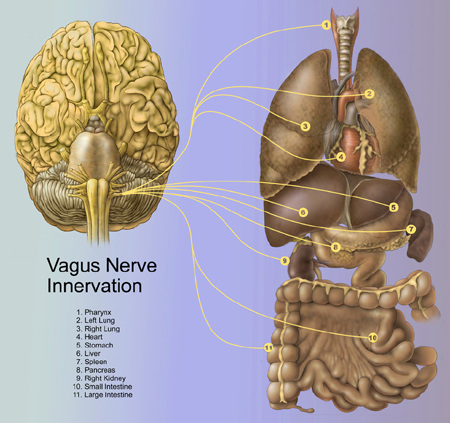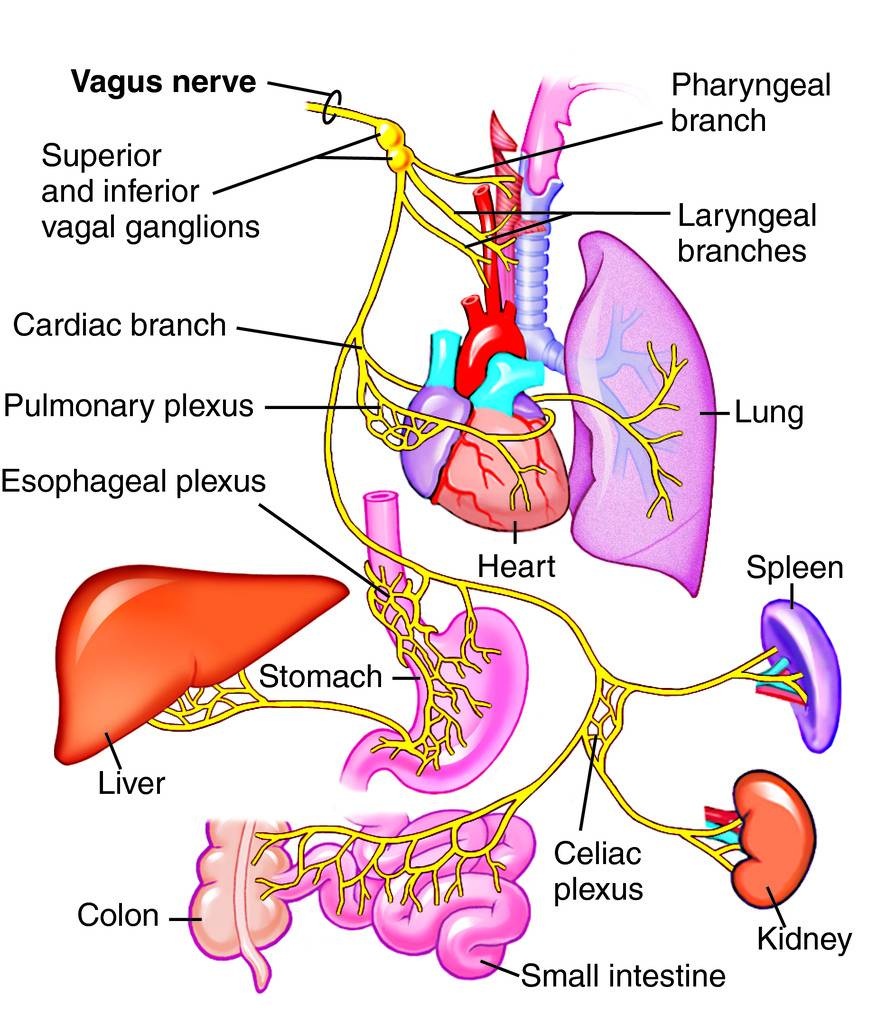|
HEALTH, LONGEVITY & AGING - As you get older, your immune system produces more inflammatory molecules, and your nervous system turns on the stress response, promoting system breakdown and aging.
That’s not just talk. It’s backed by scientific studies. For example, Kevin Tracey, the director of the Feinstein Institute for Medical Research, discovered how the brain controls the immune system through a direct nerve-based connection. He describes this as the inflammatory reflex (i). Simply put, it is the way the immune system responds to the mind. Let me explain. You immune system is controlled by a nerve call the vagus nerve. But this isn’t just any nerve. It is the most important nerve coming from the brain and travels to all the major organs. And you can activate this nerve — through relaxation, meditation, and other ancient practices, such as the Mayan system of Light Language, combined with Vagus Nerve Activation Techniques given recently by the Group & Steve Rother, the Vagus Nerve can be activated and worked with energetically through geometry, frequency, color, and light. What’s the benefit of that? Well, by activating the vagus nerve, you can control your immune cells, reduce inflammation, and even prevent disease and aging! It’s true. By creating positive brain states — as meditation masters have done for centuries — you can switch on the vagus nerve and control inflammation. You can actually control your gene function by this method. Activate the vagus nerve, and you can switch on the genes that help control inflammation. Inflammation is one of the central factors of disease and aging. Original article by Angela Savitri Petersen STRESS & THE VAGUS NERVE Your body’s levels of stress hormones are regulated by the autonomic nervous system (ANS). The ANS has two components that balance each other, the sympathetic nervous system (SNS) and the parasympathetic nervous system (PNS).
The SNS turns up your nervous system. It helps us handle what we perceive to be emergencies and is in charge of the flight-or-fight response. The PNS turns down the nervous system and helps us to be calm. It promotes relaxation, rest, sleep, and drowsiness by slowing our heart rate, slowing our breathing, constricts the pupils of our eyes, increases the production of saliva in our mouth, and so forth. The vagus nerve is the nerve that comes from the brain and controls the parasympathetic nervous system, which controls your relaxation response. And this nervous system uses the neurotransmitter, acetylcholine. If your brain cannot communicate with your diaphragm via the release of acetylcholine from the vagus nerve (for example, impaired by botulinum toxin), then you will stop breathing and die. Acetylcholine is responsible for learning and memory. It is also calming and relaxing, which is used by vagus nerve to send messages of peace and relaxation throughout your body. New research has found that acetylcholine is a major brake on inflammation in the body. In other words, stimulating your vagus nerve sends acetylcholine throughout your body, not only relaxing you but also turning down the fires of inflammation which is related to the negative effects from stress. Exciting new research has also linked the vagus nerve to improved neurogenesis, increased BDNF output (brain-derived neurotrophic factor is like super fertilizer for your brain cells) and repair of brain tissue, and to actual regeneration throughout the body. Original article by Angela Savitri Petersen Original article by Angela Savitri Petersen
WHAT IS THE VAGUS NERVE?The 10th of the cranial nerves, it is often called the “Nerve of compassion” because when it’s active, it helps create the “warm-fuzzies” that we feel in our chest when we get a hug or are moved by something… The vagus nerve is a bundle of nerves that originates in the top of the spinal cord. It activates different organs throughout the body (such as the heart, lungs, liver and digestive organs). When active, it is likely to produce that feeling of warm expansion in the chest—for example, when we are moved by someone’s goodness or when we appreciate a beautiful piece of music. Neuroscientist Stephen W. Porges of the University of Illinois at Chicago long ago argued that the vagus nerve is [the nerve of compassion] (of course, it serves many other functions as well). Several reasons justify this claim. The vagus nerve is thought to stimulate certain muscles in the vocal chamber, enabling communication. It reduces heart rate. Very new science suggests that it may be closely connected to receptor networks for oxytocin, a neurotransmitter involved in trust and maternal bonding. Our research and that of other scientists suggest that activation of the vagus nerve is associated with feelings of caretaking and the ethical intuition that humans from different social groups (even adversarial ones) share a common humanity. People who have high vagus nerve activation in a resting state, we have found, are prone to feeling emotions that promote altruism—compassion, gratitude, love and happiness. Arizona State University psychologist Nancy Eisenberg has found that children with high-baseline vagus nerve activity are more cooperative and likely to give. This area of study is the beginning of a fascinating new argument about altruism: that a branch of our nervous system evolved to support such behavior. TRE stands for Tension and Trauma Releasing Exercises. They help individuals release stress or tension as a result of difficult life circumstances, immediate or prolonged stressful situations, or traumatic life experiences. TRE consists of six simple exercises that help individuals release tension from the muscles, which in turn relaxes the anxiety of our minds, by evoking a muscular shaking process in the body.
The exercises elicit this shaking in a controlled and sustained manner. When evoked in this way, this shaking begins to release deep chronic muscular tension held within the body. They come from the center of gravity of the body (S3), which is protected by the psoas muscles. When shaking is evoked at this powerful center of the body, it reverberates throughout the entire body, traveling along the spine, releasing deep chronic tension from the sacrum to the cranium. When tension is released anywhere in the body, the brain registers a reduction in pain signals and produces new hormones for relaxation and comfort. Often, this release of tension is much like receiving an internal massage. Source: http://www.bercelifoundation.org/s/1340/aff_2_interior.aspx?sid=1340&gid=1&pgid=327 Some symptoms of tight Psoas muscle: (1) impaired breathing, (2) poor digestion from compressed abdominal contents with impaired circulation, (3) chronic constipation (from sluggish lumbar plexus function), (4) poor postural alignment, (5) poor support; gravity then drags posture down; (6) heavy-feeling legs; (7) back tension to counteract what is, in effect, a movement toward collapse. This muscular effort (a) taxes the body's vital resources, (b) introduces strain in the involved musculature (e.g., the extensors of the back), and (c) sets the stage for back pain and back spasm.
Psoas stretch: The most common psoas muscle stretch (the psoas "lunge") is done standing or kneeling. When you are standing or kneeling, balance reflexes based on your old muscle/movement memory come into play, which interferes with efforts to form new muscle/movement memory. Source: http://www.somatics.com/psoas.htm Psoas muscle
The Psoas muscle (pronounced so-as) is the deepest muscle of the human body affecting our structural balance, muscular integrity, flexibility, strength, range of motion, joint mobility, and organ functioning. Growing out of both sides of the spine, the psoas spans laterally from the 12th thoracic vertebrae (T12) to each of the 5 lumbar vertebrae. From there it flows down through the abdominal core, the pelvis, to attach to the top of the femur (thigh) bone. The Psoas is the only ‘muscle’ to connect the spine to the legs. It is responsible for holding us upright, and allows us to lift our legs in order to walk. A healthily functioning psoas stabilizes the spine and provides support through the trunk, forming a shelf for the vital organs of the abdominal core. The psoas is connected to the diaphragm through connective tissue or fascia which affects both our breath and fear reflex. This is because the psoas is directly linked to the reptilian brain, the most ancient interior part of the brain stem and spinal cord. Long before the spoken word or the organizing capacity of the cortex developed, the reptilian brain, known for its survival instincts, maintained our essential core functioning. Our fast paced modern lifestyle (which runs on the adrenaline of our sympathetic nervous system) chronically triggers and tightens the psoas – making it literally ready to run or fight. The psoas helps you to spring into action – or curl you up into a protective ball. Source: https://bodydivineyoga.wordpress.com/2011/03/23/the-psoas-muscle-of-the-soul/ "We must recognize that power and love are antithetical pursuits and values. Power creates inequalities; its use demands a suspension of feeling. Love in contrast is based on a recognition of equality. Even a relationship of a mother to her child must include the acknowledgement that the child is as much a person as she is." -Alexander Lowen, M.D., Love, Sex and Your Heart.
“Sex is the most intense manifestation of the living process. By controlling sex one controls life. We do not want to stop the life process; what we want is for it to run smoothly… like a machine. We can play with sex in the most sensual ways, but we are scared to death to explode in an orgasm of joy and ecstasy. Reich called this fear “orgasm anxiety.” In his view and mine it underlies all neurotic behavior.” From Fear of Life by Alexander Lowen, M.D.
"Love is a sharing, not a giving. A lover shares himself fully with the loved person. This will include both the sharing of joy and of sorrow. Since a pleasure shared is a pleasure doubled, the sharing of joy heightens that feeling, which can become ecstasy in the sexual embrace. The sharing of sorrow halves its pain. The joy one shares stems from the surrender to the body, not form the surrender to the other." -Alexander Lowen, M.D., Joy
"There is more wisdom in your body than in your deepest pholosophy." Friedrich Nietzsche.
|
AuthorHomayoun Shahri Archives
May 2016
Categories
All
|
Ravonkavi Privacy Policy
©2018 Ravonkavi
©2018 Ravonkavi






 RSS Feed
RSS Feed